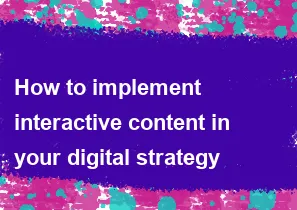How to implement interactive content in your digital strategy

Implementing interactive content in your digital strategy can greatly enhance user engagement and drive better results. Here's a step-by-step guide to help you get started:
Define Your Goals: Determine what you aim to achieve with interactive content. Whether it's increasing brand awareness, generating leads, boosting website traffic, or improving customer engagement, clear goals will guide your strategy.
Know Your Audience: Understand your target audience's preferences, interests, and pain points. Tailor your interactive content to resonate with their needs and preferences for maximum effectiveness.
Choose the Right Type of Interactive Content: There are various types of interactive content you can leverage, such as quizzes, polls, surveys, calculators, assessments, contests, interactive infographics, interactive videos, and more. Select formats that align with your goals and audience preferences.
Create Compelling Content: Develop interactive content that provides value to your audience. Ensure it's visually appealing, user-friendly, and offers an engaging experience. Use multimedia elements like images, videos, and animations to enhance interactivity.
Select Suitable Platforms: Determine the digital platforms where you'll host your interactive content. This could include your website, social media channels, email newsletters, or dedicated landing pages. Choose platforms based on where your audience is most active.
Promote Your Interactive Content: Utilize various marketing channels to promote your interactive content. Share it on social media platforms, incorporate it into email campaigns, feature it on your website, and consider paid advertising to reach a wider audience.
Encourage Sharing and Engagement: Include social sharing buttons and calls-to-action within your interactive content to encourage users to share it with their networks. Engage with users who interact with your content by responding to comments, answering questions, and fostering discussions.
Track and Analyze Performance: Monitor key metrics to evaluate the performance of your interactive content. Track metrics such as engagement levels, conversion rates, time spent on content, bounce rates, and social shares. Use analytics tools to gain insights into what's working and what needs improvement.
Iterate and Optimize: Based on the insights gathered from analytics, refine your interactive content strategy continuously. Experiment with different formats, messaging, and distribution channels to optimize performance and achieve better results over time.
Stay Updated: Keep abreast of emerging trends and technologies in interactive content marketing. Regularly update your strategy to incorporate new ideas and innovations that can further enhance user engagement and drive success.
By following these steps and continually refining your approach, you can effectively integrate interactive content into your digital strategy to captivate your audience and achieve your marketing objectives.
-
Popular Post
- How to optimize for Google's About This Result feature for local businesses
- How to implement multi-language support in an Express.js application
- How to handle and optimize for changes in mobile search behavior
- How to handle CORS in a Node.js application
- How to use Vue.js with a UI framework (e.g., Vuetify, Element UI)
- How to configure Laravel Telescope for monitoring and profiling API requests
- How to create a command-line tool using the Commander.js library in Node.js
- How to implement code splitting in a React.js application
- How to use the AWS SDK for Node.js to interact with various AWS services
- How to use the Node.js Stream API for efficient data processing
- How to implement a cookie parser middleware in Node.js
- How to implement WebSockets for real-time communication in React
-
Latest Post
- How to implement a dynamic form with dynamic field styling based on user input in Next.js
- How to create a custom hook for handling user interactions with the browser's device motion in Next.js
- How to create a custom hook for handling user interactions with the browser's battery status in Next.js
- How to implement a dynamic form with dynamic field visibility based on user input in Next.js
- How to implement a dynamic form with real-time collaboration features in Next.js
- How to create a custom hook for handling user interactions with the browser's media devices in Next.js
- How to use the useSWRInfinite hook for paginating data with a custom loading indicator in Next.js
- How to create a custom hook for handling user interactions with the browser's network status in Next.js
- How to create a custom hook for handling user interactions with the browser's location in Next.js
- How to implement a dynamic form with multi-language support in Next.js
- How to create a custom hook for handling user interactions with the browser's ambient light sensor in Next.js
- How to use the useHover hook for creating interactive image zoom effects in Next.js